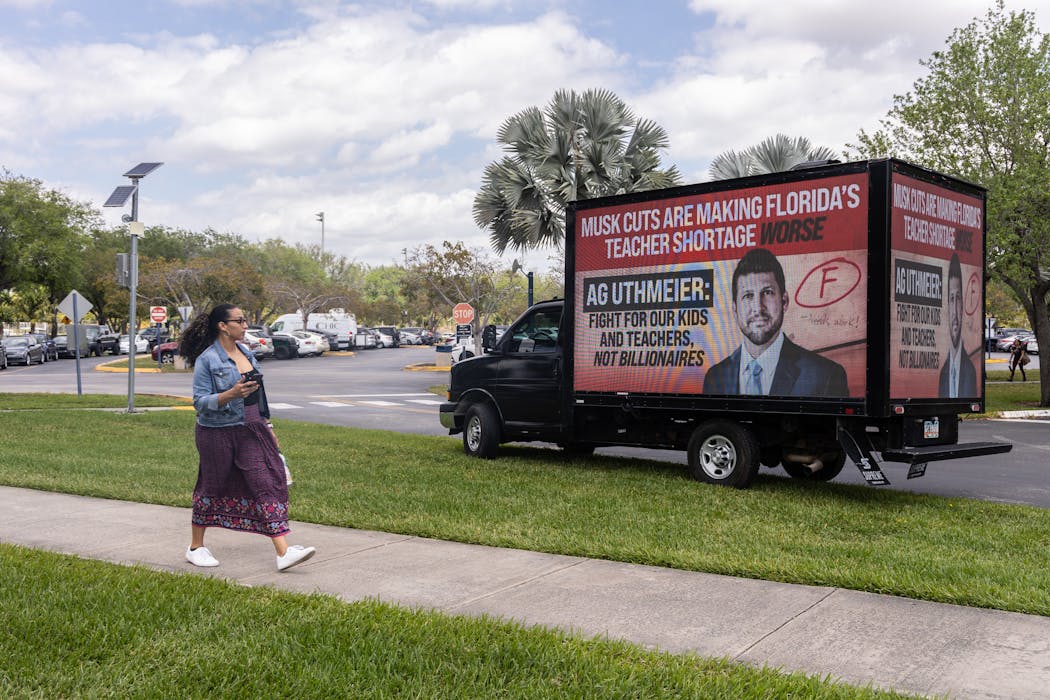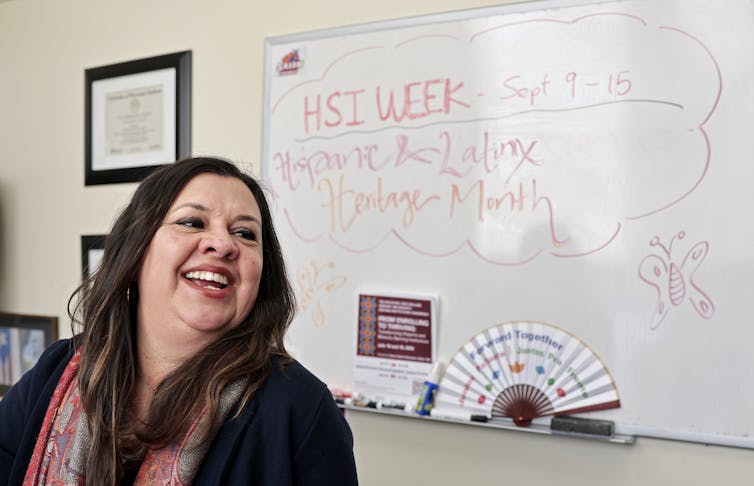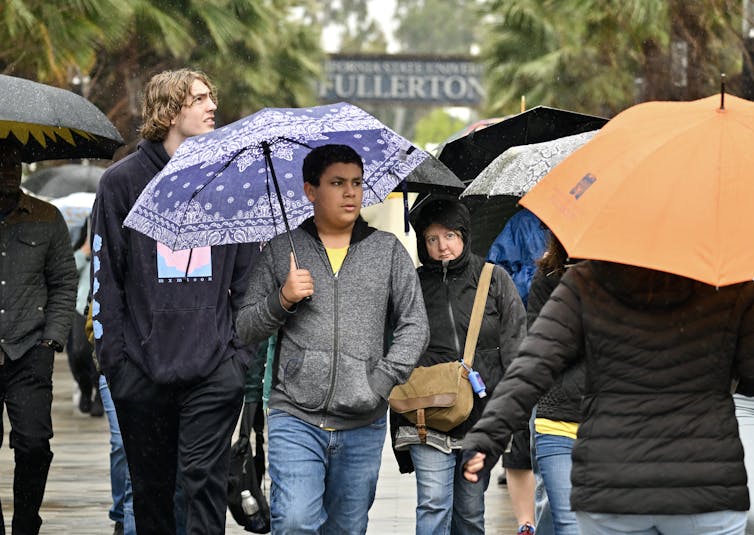Trump is cutting funding to universities with large Hispanic student populations – here’s what to kn
Hispanic-Serving Institutions enroll over 60% of all Hispanic undergraduates in the US and include large schools like Florida International University.

The Trump administration is trying to eliminate diversity, equity and inclusion programs as part of a broader campaign to end what it calls “wokeness” in American education.
As part of this rollback, the Justice Department announced in July 2025 that it would no longer “defend” the federal definition of Hispanic-Serving Institutions, or HSIs. These are colleges where at least 25% of undergraduates identify as Hispanic or Latino.
This is more than a legal technicality. It reflects the Justice Department’s position that HSI grants violate constitutional protections, putting millions of federal dollars for these schools at risk.
Citing this legal rationale, the Department of Education confirmed in September that it had frozen US$350 million in education grants intended for Minority-Serving Institutions. This includes more than $250 million for HSIs, specifically.
The Education Department argues that these programs amount to racial discrimination because they tie federal grants to students’ racial or ethnic backgrounds.
This echoes the Supreme Court’s decision in 2023, which narrowed how colleges can consider race and ethnicity in admissions.
I serve as the university diversity officer at California State University, Chico, an HSI. I am also an ethnic studies scholar who focuses on equity in higher education.
Advocates for HSIs say ending federal funding would hurt already underfunded colleges, particularly those that serve large numbers of first-generation and low-income students.

What are Hispanic-Serving Institutions?
Congress created the HSI designation in 1992, through an amendment to the 1965 Higher Education Act. This amendment authorizes federal grants to help strengthen colleges that enroll large numbers of Hispanic and low-income students, providing more opportunity for those students to succeed and graduate.
There are more than 600 federally designated HSIs across the U.S. and Puerto Rico. California is home to the most HSIs, with 167, followed by Texas, Puerto Rico, New York and Illinois.
In addition to showing that at least 25% of its student population is Hispanic or Latino, any college or university that wants to qualify as an HSI must also show that at least half of its students come from low-income backgrounds.
Becoming an HSI allows colleges and universities to apply for federal funding intended to support underrepresented and low-income students.
HSIs vary in size and mission
HSIs enroll over 1.5 million Hispanic students, which amounts to over 60% of all Hispanic undergraduates in the U.S.
This marks a big increase from the 340,000 Hispanic undergraduates who attended an HSI in 1995.
Some of these schools are large public research universities, such as University of California, Riverside; University of California, Santa Barbara; and University of California, Santa Cruz. Others are regional institutions, private colleges and local community colleges.
Over the past decade, another kind of Hispanic-Serving Institution has emerged – research-intensive HSIs. These are colleges and universities where at least 25% of the student body is Hispanic and where there is significant research funding and a range of doctoral programs offered. These schools include University of California, Irvine; Florida International University; and the University of Texas at El Paso, among others.
Some researchers have debated whether the HSI category has become too broad, grouping schools with vastly different resources, missions and student populations.
Despite their differences, many HSIs enroll large numbers of first-generation, low-income and working students, as well as immigrants and transfer students.
HSIs also generally operate with fewer financial and academic resources than comparable non-HSI institutions.
How HSI funding works
Title V grants from the Department of Education are one clear way that HSIs can receive federal funding .
These competitive grants are intended to help HSIs expand educational opportunities and institutional capacity to support Hispanic and low-income students.
Rather than providing aid directly to students, Title V grants are used to offer faculty training, update classrooms and laboratories, create new degree programs and develop mentorship opportunities for first-generation students.
At campuses such as California State University, Chico and University of California, Irvine, Title V grants have given schools the money to create bilingual advising services and maintain data systems.
Title V grants form only one part of the broader funding picture for HSIs. Like many colleges, HSIs rely on state funding and tuition revenue. They also compete for other federal grants, including those from the National Science Foundation and the Department of Agriculture.
How HSIs help Hispanic students
A growing body of research shows that HSIs are crucial in helping more Hispanic and first-generation students attend and graduate college.
Some HSIs have received national recognition for using evidence-based practices to help Hispanic students perform better in the classroom. Hispanic students at these schools, which include Arizona State University and California State University, Fullerton, graduate at rates roughly 8 percentage points higher than Hispanic students nationally.
Hispanic students at HSIs graduate at rates more than 5 percentage points higher than those at comparable non-HSI colleges, according to similar 2017 findings from the nonprofit Education Trust.
There are a few reasons why there is a relatively high graduation rate for Hispanic students at HSIs.
Students at HSIs often report feeling a strong sense of belonging and see their own cultures reflected in the curriculum. Many HSI campuses also offer dedicated programs for first-generation students and train faculty to teach and advise with equity and inclusion in mind.
At University of California, Irvine, where I helped lead HSI initiatives, Hispanic undergraduate enrollment grew by nearly 150% between 2009 and 2019, from 3,000 students to more than 7,500.
During that time, more than 350 faculty and staff completed equity-focused training to strengthen advising and teaching practices that support Hispanic and other underrepresented students.

What’s at stake for HSIs
Hispanic Americans now make up nearly 20% of the U.S. population, and their college enrollment numbers are projected to grow from about 3.7 million in 2020 to 4.5 million by 2030, as overall college enrollment numbers are projected to decline during this time.
A national evaluation of Title V projects found that most colleges and universities used these grants to improve student services, develop new academic programs and build community partnerships that help first-generation and low-income students stay enrolled and complete their degrees.
As HSI researchers note, graduation rates tell only part of the story. True student success at HSIs depends not just on graduation numbers, but on culturally responsive teaching, inclusive campus climates and equity-minded institutional practices.
How policymakers define and fund HSIs will shape not only the future of these institutions but also whether this growing generation of Hispanic students can access, afford and complete college in the years ahead.
Joseph Morales, Ph.D., works at California State University, Chico, a federally designated Hispanic-Serving Institution (HSI). While not a principal investigator on any federal HSI grants, he has participated in professional development programs and national conferences hosted by organizations mentioned in the article, including the Hispanic Association of Colleges and Universities (HACU). These experiences inform his understanding of the field but did not influence the content of this piece. The views expressed are those of the author and do not necessarily reflect the views of California State University, Chico.
Read These Next
Black-market oil buyers will push Venezuela for bigger discounts following US seizure – starving Mad
Venezuela relies on the black-market oil trade for a large chunk of its revenue. US enforcement actions…
As a former federal judge, I’m concerned by a year of challenges to the US justice system
A university president who’s a former federal judge looks at the rule of law and the Trump administration’s…
AI’s errors may be impossible to eliminate – what that means for its use in health care
Many health symptoms can be caused by multiple illnesses – if AI can’t tell the difference between…





